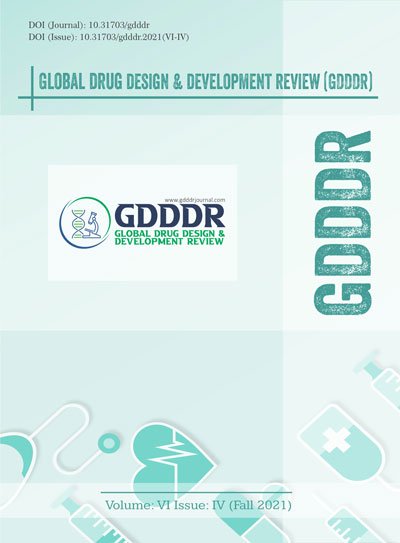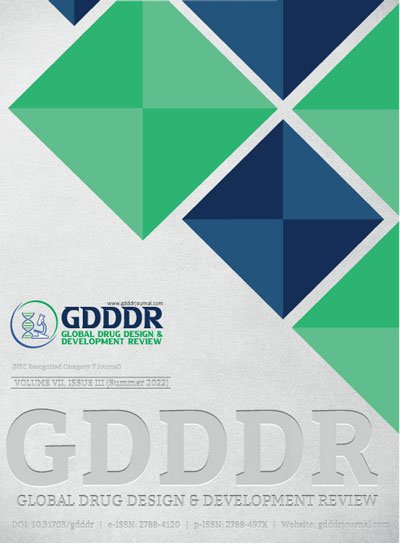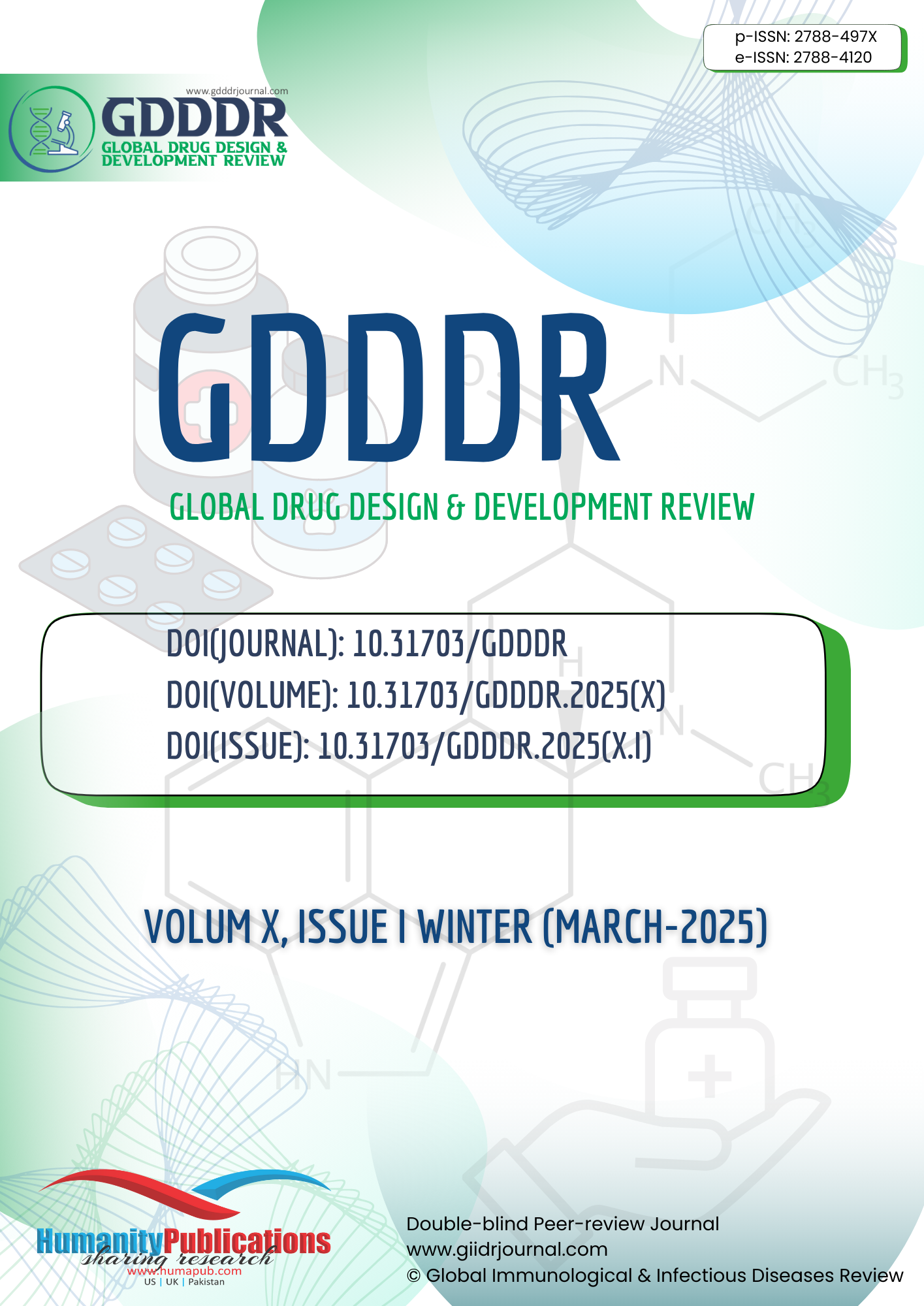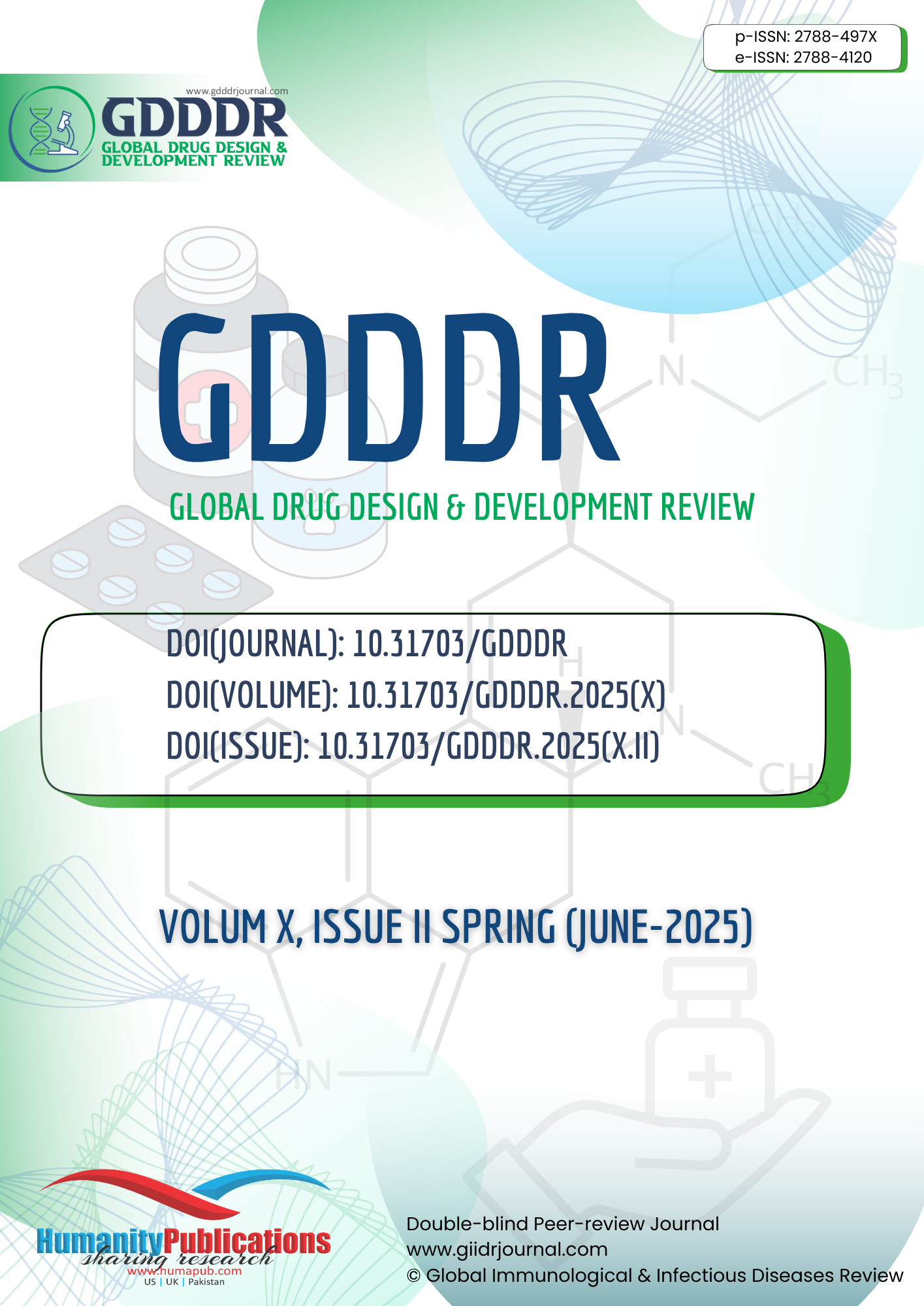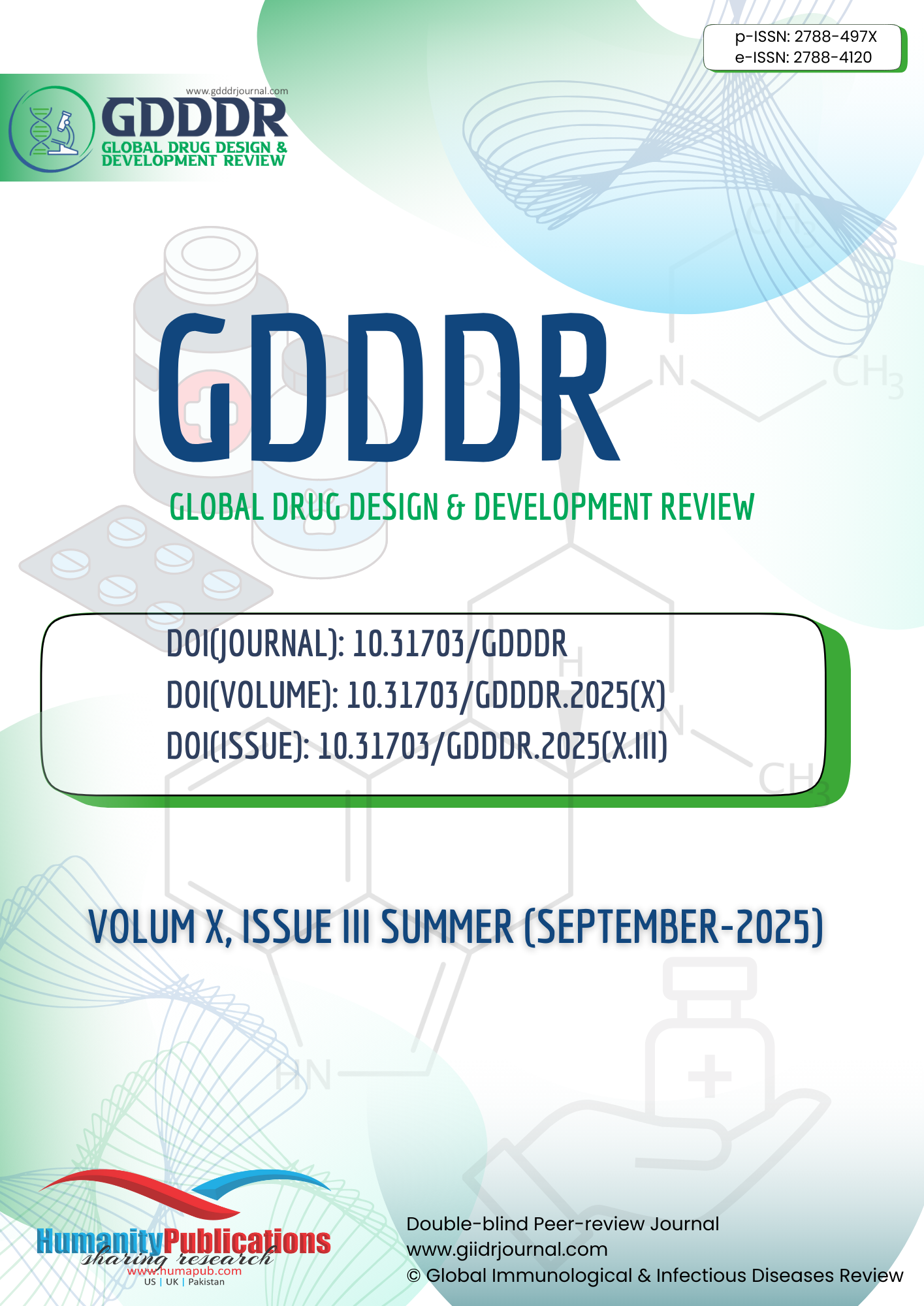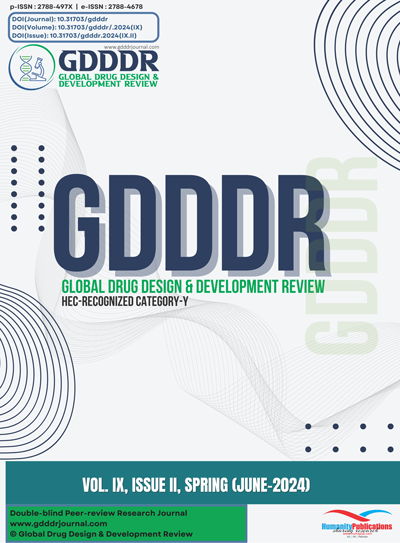
Global Drug Design & Development Review
-
Address
Office #1,2, First Floor, Fazal Arcade,
F-11 Markaz, Islamabad, Pakistan. -
Email address
managingeditor@gdddrjournal.com
Monday to Friday 9am - 7pm -
Contact information
info@gdddrjournal.com, +92 332 9147618
Monday to Sunday 24 Hours
- Publishing research Since2016
- Publication FrequencyAnnual
- Access TypeOpen Access
Global Drug Design and Development Review (GDDDR) intends to promote qualitative and quantitative researches and findings with the help of newly emerging tools and patterns utilized in experiments, observations, interviews, analysis and surveys by encircling all major segments of Drug design and Interdisciplinary academic and research disciplines. GDDDR is a Inter-disciplinary, quarterly published, double-blind peer-reviewed research journal which encompasses major disciplines of Drug design in general with specific interest in the sub-disciplines detailed below. In order to facilitate the translation of cutting-edge drug delivery technologies into improved patient outcomes, it is important to establish a platform for rigorous, peer-reviewed research that bridges the gap between drugs design, development, and clinical practice. All the review articles published will be comprehensively peer-reviewed by the team of GDDDR to ensure their scientific authenticity, innovation, and excellence.
- GDDDR contains notable research contributions selected on the base of merit.
- It serves as a national and international platform to undergrad students and researchers.
- It focuses to target the researchers from different fields serving in the vicinity of drug design and development.
- GDDDR functions as a multi-disciplinary research deploying various fields.
- It encourages and supports the researchers and creates a network between the undergrad students, researcher scholars and teachers to carry out inventive research ideas in a productive way.
Cancer patients are increasingly using nutritional supplements, which raises questions about safety as well as possible advantages. This review looks at the functions of vitamins, probiotics, polyphenols, and immune-boosting foods in cancer treatment. Certain supplements can enhance treatment results, lower inflammation, or boost the immune system, but others might ... read more
PDF Full TextJournal Metrics
Journal Indexing
Scope
The scope of this journal is extended to the researchers working as pharmacists, chemists, chemical engineers, biologists, oncologists working in R&D of drugs and biologics, scientists working in pharmacological engineering and biotechnology. It implements multi-disciplinary fields, GDDDR is publishing the review articles in the following domains;
- Medicinal Chemistry
- Structural or molecular biological studies elucidating molecular recognition processes.
- Fragment-based drug discovery.
- Drug target identification and validation.
- Pharmaceutical Technology
- Design, synthesis, and biological evaluation of novel biologically active compounds.
- Phenotypic screening and target deconvolution.
- Preclinical and Clinical Pharmacology
- Preclinical development studies.
- Translational animal models.
- Mechanisms of action and signaling pathways.
- Distribution, pharmacokinetics and metabolic transformations of drugs or biologically active compounds in drug development.
- Drug delivery and formulation (design and characterization of dosage forms, release mechanisms and in vivo testing).
- Pharmacognosy
- Isolation, structural characterization, biosynthesis, bioengineering and pharmacological evaluation of natural products.
- Bioinformatics
- In Silico drug designing.
- Identifying targets for drug discovery using bioinformatics.
- Computer-aided drug designing
- Biotechnology
- Use of fluorescent probe for fast and quantitative detection of chemicals in blood
- genomics-based drug design and discovery
- Clinical Practice
- Pharmaceutical formulation science: is covered in detail, with a focus on dosage form development and design, stability investigations, and formulation techniques that increase drug bioavailability and patient compliance.
- Clinical Pharmacokinetics: This field of study focuses on the pharmacokinetics of medications administered via various delivery systems. It examines the factors that affect drug distribution, metabolism, and elimination, with particular attention to how these aspects relate to clinical outcomes.
- Cover a wide range of therapeutic areas, including oncology, neurology, cardiology, and infectious illnesses, and explain how advances in drug delivery technologies are increasing therapy options in each area.
- Address the unique requirements of pediatric and elderly patients, with an emphasis on age-appropriate drug administration methods, dosages, and safety considerations.
- Drug-Drug Interactions: Examine possible drug-drug interactions that might result from intricate drug delivery systems, providing guidance on how to manage polypharmacy and reduce unfavorable effects.
- Publish studies on the biopharmaceutical elements of drugs delivery, including as drug solubility, permeability, and formulation techniques to address absorption issues.
- Keep readers informed on cutting-edge drug delivery breakthroughs, including 3D printing, implantable technology, and gene delivery systems.
- Articles on methods for educating patients and healthcare professionals about drug delivery systems should be included in the section on patient education and counselling to help patients understand their medications and adhere to them.
- Safety and toxicology: Discuss potential toxicity, side effects, and ways to improve safety profiles as they relate to drug delivery systems.
- Reflect a worldwide perspective by including studies and reviews from other countries, encouraging the sharing of knowledge and best practices in clinical pharmacy practice.
- Drug Design and Molecular Insights: Emphasise papers that connect drug design principles with drug delivery strategies, illuminating the molecular underpinnings of drug interactions and therapeutic mechanisms.
Editorial Board

Dr. Fahad Pervaiz, Associate Professor in Pharmaceutics, Department of Pharmaceutics, The Islamia University of Bahawalpur, Bahawalpur, Punjab, Pakistan.
fahad.pervaiz@iub.edu.pk

Dr. Muhammad Farhan Sohail, Associate Professor, Riphah International University, Raiwind Road Campus, Lahore, Punjab, Pakistan.
farhan.sohail@riphah.edu.pk

Dr. Malik Ihsan Ullah Khan, Assistant Professor, Institute of Molecular Biology and Biotechnolog, University of Lahore, Punjab, Pakistan.
ihsan.ullah@imbb.uol.edu.pk

Maria Hassan Kiani, Lecturer, Department of Pharmacy, Faculty of Biological Sciences, Quaid-i-Azam University, Islamabad, Pakistan.
marria.h.kyani@gmail.com
Advisory Board

Dr. Waqar Aman, Associate Professor, School of Pharmacy, University of Management and Technology, Lahore, Punjab, Pakistan.
waqar.aman@umt.edu.pk

Dr. Muhammad Shafeeq ur Rahman , Associate Professor, Faculty of Pharmaceutical Sciences, University of Central Punjab Lahore, Punjab, Pakistan.
shafeeq.rahman@ucp.edu.pk

Dr. Muhammad Imran Khan, Professor, Riphah Institute of Pharmaceutical Sciences, Riphah International University, Raiwind Road Campus, Lahore, Punjab, Pakistan.
Niazipharmacistms@yahoo.com

Dr. Amina Riaz, Assistant Professor, Department of Pharmacy, The Women University Multan, Punjab, Pakistan.
aminaranjha@yahoo.com
Archives
Despite years of clinical research and trials of encouraging new therapies, cancer remains a leading cause of morbidity and mortality. The fragment-based drug discovery has evolved formerly as an efficient approach for identification, optimization, and generation of lead. After identifying the fragments having binding affinity with the target using computational method for fragment screening, t... read more
PDF Full Text Views (5764)There are many publications that deal with administration of test substances to animals and removal of blood samples for different objectives. Parenteral route of drug administration includes further different routes i.e., drug administration through muscles (IM route) through veins (IV route) and through subcutaneous route. We can manage to check the outcomes of test substances within minutes ... read more
PDF Full Text Views (5433)Pharmacokinetic modeling helps to estimate the ADME parameters of all the natural and synthetic drug substances in humans and animals. There are two types of approaches for predicting the kinetic processes inside the body i.e., model approach and model independent approach. Model approach is further divided into compartmental and physiological models and model independent approach consists of n... read more
PDF Full Text Views (3342)Artemisia annua L. is acknowledged as a traditional medicinal plant bearing potent antimalarial, read more PDF Full Text Views (2717)
Oral route of drug administration is the most common among all routes and hence their pharmacokinetic and pharmacodynamic factors are substantial to study. Among such factors, GIT absorption is the key factor in new drug development affecting the efficacy as well as safety of the drug. Different protocols have now been developed for the usage of in vitro also the in vivo as well as in situ meth... read more
PDF Full Text Views (2577)Pharmacokinetics can be defined as what the body does to a drug. The basic parameters of pharmacokinetics are discussed here including absorption, distribution, metabolism, and excretion. Characteristics and pathways taken by these drugs are determined by these parameters. The mechanism followed by these parameters are also discussed. Furthermore, the factors affecting these parameters includin... read more
PDF Full Text Views (2452)The aim of this research was carried out to investigate the effect of different sugar concentrations and chemical preservatives and storage temperature, i. e. refrigeration temperature (4-10oC) on the physicochemical and sensory attributes of strawberry juice stored for one year. The samples were numbered as, TR28=Strawberry juice (20.5 brix) with 0.1 Percent sodium benzoate, TR30=Strawberry ju... read more
PDF Full Text Views (2384)Various types of material are produced by using nanotechnology techniques at nano scale level. Nanoparticle is wide class of nanotechnology having one dimension and particle size less than 100 nm. Nano particles has wide range of application in the field of biomedical because a large number of nano materials such as nano carriers, nanotubes, nanowires and nanorods have been developed. In this r... read more
PDF Full Text Views (2372)In several pharmacologic, pharmacology, and alternative medicine studies, oral administration of medication or test substances to experimental animals is needed. It is clinically sound and recommended to administer test substances to experimental animals along the same route that they are taken or expected to be taken by humans as general bioavailability; the pharmacology and pharmacology param... read more
PDF Full Text Views (2350)Mathematical model a numerical classification of the biological framework and utilized to state quantitative connections. A pharmacokinetic compartment is a numerical idea that portrays a space in the body that medication seems to possess These models just mediate the test information and permit an experimental equation for the assessment of medication focus with time. A non- compartmental mode... read more
PDF Full Text Views (2303)Telehealth provides medical treatment, patient education, self-care, and health information using digital communication technology. Telehealth involves remote data exchange between a patient and a healthcare provider. Telehealth may enhance health care in underdeveloped countries. This research examines how Pakistani physicians and nurses see telemedicine for cardiovascular disease therapy. We ... read more
PDF Full Text Downloads (0)A prospective analytical study was conducted at the Urology Department of Gujranwala Teaching Hospital from January 2022 to April 2023. The aim was to experience the safety & efficacy of supine PCNL performed at tertiary care hospital at Gujranwala which is being performed in few centers in Pakistan. A total of 98 patients undergoing percutaneous nephrolithotomy (PCNL) were included in the ... read more
PDF Full Text Downloads (0)The study compares the role of suprapubic cystostomyread more PDF Full Text Downloads (0)
Cancer patients are increasingly using nutritional supplements, which raises questions about safety as well as possible advantages. This review looks at the functions of vitamins, probiotics, polyphenols, and immune-boosting foods in cancer treatment. Certain supplements can enhance treatment results, lower inflammation, or boost the immune system, but others might ... read more
PDF Full Text Downloads (0)The global burden of cancer, with deaths projected to increase from 7.6 million to 13.1 million by 2030, calls for urgent research into potential mitigating factors, such as Vitamin D levels. This study specifically addresses the correlation between Vitamin D and cancer prevalence among women of reproductive age, scrutinizing variables like age, socioeconomic background, and geographic location... read more
PDF Full Text Downloads (0)To examine the prevalence and pattern of hypoxic-read more PDF Full Text Downloads (0)
This article offers a deep analysis of activating streptokinase which looks into the biotechnological challenges and future perspectives. One of the main problems associated with streptokinase is its short half-life, complex production process, and immunogenicity which hinders patients from getting a successful reperfusion. Yet, the development of biotechnology methods that would not face these... read more
PDF Full Text Downloads (0)Medication shortages are a global issue that disrupts pharmacy services and negatively impacts patient care. The Drug Regulatory Authority Pakistan (DRAP) has set a benchmark for the drugs and medication supply committee. This study was conducted in five key regions of Pakistan and found that 55% of physicians and pharmacists encountered medication shortages. This study aimed to assess the perc... read more
PDF Full Text Downloads (0)Diabetic foot ulcers, caused by diabetes-related nerve and blood vessel damage, can lead to amputations. Silicone insoles help prevent ulcers but are often expensive. Affordable, customized insoles are available, making prevention more accessible. This research aims to create affordable, locally manufactured silicone insoles for diabetic foot ulcers, reducing costs ... read more
PDF Full Text Downloads (0)Only educated people can develop a nation. Educational success requires good testing. read more PDF Full Text Downloads (0)








